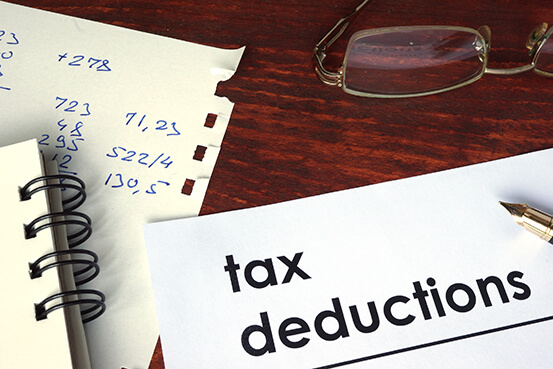Whether you are seasoned or new to independent contractor work, or have always has a freelance graphic designer contract template in place, graphic designer taxes are still a part of life. Insert the eye-rolls and the procrastination we all go through when it comes to our taxes. Instead of panicking or stalling though, take control of them, like a boss.
Yes, being your own boss can be a bit scary, especially when it comes to filing your taxes. Unmasking the monster always made things better as a kid, so let’s break down how to pay taxes as a freelancer.
Freelance graphic designers must file a 1099 tax return. Freelancers are considered business owners. These graphic designers are subject to income tax and self-employment tax and must use a Schedule C form with their personal taxes.
Read this quick guide to get an overview of what to expect, how it all works together, and what you need. We'll also show you how you can use the best online software for freelancers to lower their tax liability.
Note: Bonsai Tax is a software designed to make freelancer taxes easy. If you are looking to track expenses, get notified for deadlines and estimate your quarterly taxes all in one place, try a 14 day free trial of our app. Users typically safe $5,600 by using our software.

What do I Need to File My Business Taxes?
First, gather all the information about you and your business you may need to file your taxes.
- Your Personal Id/License
- Your personal social security card (or Freelance Business EIN )
- Health insurance forms (1095 A, 1095 B)
- All income documents (1099-NEC from clients)
- Business expense records (you can deduct cell phone expenses, internet costs, subscriptions, marketing, website expenses, software for graphics, all costs related to your business)
- Business use records for assets you own (when you placed the asset in service, vehicle costs, a percentage on some equipment, property, home office, computer)
- Home office space deduction information (square footage, rent, mortgage interest, utilities, insurance bill, rental, receipts or contracts related to repair)
- Estimated payments made ( 1040-ES records)
- Your banking information (routing, account numbers )
These are the basics. On occasion, there will be documentation you need to seek out. Some of these documents may be e-mailed to you, retrievable online, on a website, or stored on some kind of software.

What Forms a Freelance Graphic Designer May Need
Let’s get to know some of the forms you may need with your freelance business and how they help us.
Think of these forms like a buffet; you start with a plate, right?
The plate, so to speak, is tax form 1040.
The 1040 form is used for personal federal income tax returns filed by residents of the United States. In other words, Form 1040 is used to calculate your taxable income and exactly how much tax is owed on that income.
Every year, employees and independent contractors must complete and submit a 1040 tax form by the tax deadline.
The other forms are additions to better reflect specifics to various tax situations and correlate with the 1040.
Schedule C
This is the main form you need as a freelancer. This is where you report profits and losses regarding your business.
This is not only where you report business gains, but a place to show your expenses (Losses) or tax deductions. Read here for instructions to fill out Schedule C.
1099-NEC
The 1099-NEC is a form a client or business may send graphic designers showing the amount they paid for your work.
A 1099-NEC is not a W2 or a Schedule C. The 1099-NEC is used to report non-employee compensation. Stay on top of the 1099-NEC deadline to avoid any unnecessary fines or penalties.
A client or business is not required to send a 1099-NEC if they didn’t pay a designer over $600. So freelancers won’t receive a 1099 under $600. This means you’ll need to track your business income, write it down, and stay organized.
Records are vital and will keep things clear and simple.
1040-ES
A 1040-ES is just a prediction about what your taxes are going to be for the year. This is a way to stay ahead of your tax bill and estimate as well as make payments for what you may owe. A graphic designer needs to pay taxes quarterly in order to not get a surprise penalty when filing during tax time.
There are tons of other forms available for just about anything you need to tell the IRS about your business. These are just the basics of what a freelance designer may need.
Now that we know the forms, Let’s talk about business expenses and quarterly taxes.

Business Expenses and Estimated Taxes
Social Security and Medicare Tax are rolled together basically as a payroll tax required through the Federal Insurance Contributions Act (FICA) or the Self-Employed Contributions Act (SECA).
Both employee and employer contribute, essentially splitting the bill.
As a freelance Designer, you are both employer and employee; let’s check out how that works.
Self-employment taxes
The Self-Employed tax rate is applied to your net earnings at a rate of 15.3% on up to $142,800 as of 2021; after that, the social security portion is capped.
Any earnings of more than $142,800 are still taxed for the medicare portion at 2.9%, as there is no limit on medicare tax.
There may be an addition of 0.9% medicare tax on earnings of $200,000 or more for a single filer or $250,000 or more for joint filers. You can use our online self-employment tax calculator to total up your tax liability for the year.
What are Quarterly Taxes?
The U.S. has you pay taxes throughout the year instead of all at once. You can calculate your quarterly tax payments by taking your total tax liability (self-employment taxes, income taxes, etc) from the previous year and dividing that number by 4. Be sure to send the correct amount to the IRS. If you pay less than your expected amount or make uneven payments, you may receive penalty for tax underpayment.
Quarterly taxes are broken down into four sections (quarters); each quarter is four months.
So, the due dates for quarterly tax payments are:
- April 15
- June 15
- September 15
- January 15 (of the following year)
You can send payments directly on the IRS’ website via Direct Pay. This makes tax payments more manageable throughout the year for your graphic design business.

Tax Deductions, Adjustments, and Credits
Like anything related to taxes, there are various calculations, requirements for anything deductible expenses, and forms.
Yes, that can be intimidating. Luckily, you don’t have to fill out every form available.
Think of these forms as an opportunity to save you money or lower your payments.
Above The Line Tax Deductions
Above the line deductions is where we start to deduct. These adjustments are the first steps to reducing and calculating your taxable income or Adjusted Gross Income (AGI).
For example:
- Self-Employed Deduction - you can deduct The Employer portion; 50% is deductible as a business expense.
- SIMPLE Retirement Contributions or SEP
- Health Insurance - for you and your family
The Line AKA Adjusted Gross Income (AGI)
AGI is your gross income (Total Income) minus the adjustments like credits and above-the-line deductions. AGI is the amount of your income that’s taxable and the amount used to determine your tax bracket.
Pro Tip for Form 1040: no matter what year, the AGI is on the line labeled ‘Taxable Income’. Keep track of your AGI. It may be used for financial business, accessing prior returns, even Identification.
Below The Line Tax Deductions
Below the line tax deductions are anything you deduct after the AGI (Taxable Income).
Some Examples of Below the Line Tax Deductions are:
- Charitable donations deduction
- Education fees deduction
- Some memberships and subscription fees
- Office supplies
- Marketing expenses
- Client management software (CMS) expenses
- Internet expenses
- Office space
- Graphic design classes
Note: If you would like an app to track all your deduction for you, click here to claim your 7-day free trial of Bonsai Tax. Our tax software will organize and categorize your tax receipts to help you maximize your tax savings. Users save an average of $5,600 from their tax bill by using our app.
Do Freelance Designers Qualify for Credits?
Being an independent contractor doesn’t disqualify you from leveraging tax credits. A tax credit is a type of tax break that allows eligible taxpayers to deduct the amount of the credit from the total amount they owe the state. Always check for any deductible credits.
A Few Credit Options
- Adoption Credit - Up to $14,440 credit per eligible child for 2021
- Earned Income Credit - From $543 to $6,728 depending on several factors.
- Child Tax Credit - (Recently Updated) $3000 per child ages 6 -17 and $3,600 for ages 5 and under.
- Saver’s Credit - worth up to $1000 or $2000 for Joint filers for contributions to retirement savings.
- Eligibility requirements vary for each credit.
If you have any questions about claiming a tax credit, we always recommend you seek the advice of a tax professional
Tax Write-Offs for a Graphic Design Business
Taking advantage of deductible business expenses on your tax return, even just a percentage, can have a significant impact on how much you may have to pay.
Like if you work from home, the home office deduction is an excellent write-off. Even rental expenses, like an apartment, may still be deductible.
Keep in mind, only a percentage is claimed on some tax write-offs. You'd want to organize your tax receipts for:
- Mortgage interest
- Rent
- A percentage of utility costs (deductible if you work from home, rent, or own office space)
- A portion of professional repairs (equipment, computer, car, office, may also be tax-deductible if related to your business)
- Parking fees
- Temporary relocation expenses, gas, meals, car, office
- Cell phone costs and internet expenses
- Shipping supplies
- Online classes
Check out our full list of graphic designer tax deductions available for freelancers.
Only deduct your costs of doing business. These expenses are only tax-deductible as long as a client hasn’t already given you money for your business-related expenses. Don’t double-dip. This means it can’t be a tax write-off if the expenses or fees were reimbursed to you already.
If you are looking for an app to automatically scan your bank account/ credit card statements and organize your tax deductions, try Bonsai Tax’s 1099 expense tracker. Our tax software categorizes all your business expenses for you and maximizes your tax savings.
If you are looking for a free way to track your expenses, try our free excel template to track 1099 expenses.

Time To Breeze Through Your Taxes
Now that we have gone over the basics, we can deduct the jargon; you have a clear view of what’s ahead. Not so scary, right!
Always remember, you have come this far by taking charge of your career path and being brave enough to build your own business.
Don’t let the IRS scare you, plus you already have someone in your corner with Bonsai. Supporting freelancers is what they do and who they are; signup for a Free trial with Bonsai today. You are a boss, but you don’t have to manage your taxes alone.







